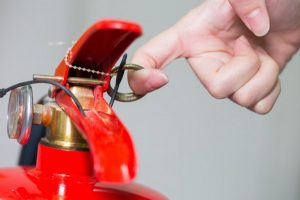
Making sure your fire extinguishers work is essential.
Making sure your fire extinguishers work is essential. One way to confirm that is by conducting what is known as a hydrostatic test. However, since many building owners and facility managers do not know how to do this, it is best to leave it to the experts. Here is more information about hydrostatic testing.
The Importance of Visual Inspections
The first step in any hydrostatic test is a visual inspection. During this phase, the technician can assess the cylinder of the fire extinguisher for any visible signs of damage. Because the testing involves putting the cylinder under pressure, there must be a quick check for flaws before it can begin. This prevents injury to the technician and damage to the room where the testing is taking place. Worn out cylinder threads, signs of corrosion, deep dents, signs of repairs or abuse, and heat damage can all be discovered through thorough visual inspections.
Hose Removal
The next step in the process involves removing the hose from the fire extinguisher. Then the hydrotest adapter is plugged into its place so it can capture the extinguishing agent when the discharge step is undertaken.
Discharge
The technician will then begin the third step of the hydrostatic testing process: the release. This is meant to let out of all of the extinguishing agent so that it does not interfere with the test results and give incorrect results, which can cause further problems at the worst possible time.
Valve Removal
As soon as the extinguisher is completely discharged, the next phase of the test can begin. This is where the valve is removed. With the lid off, this means that the interior of the cylinder can be adequately inspected. The purpose of removing the valve is to see if there are any problems inside the cylinder, such as pitting. If pitting is detected, then the fire extinguisher is taken out of the testing pool and set aside. The cylinder can no longer be used, so testing it would not make sense.
Pressure Testing
Pressure testing is the next phase of the trial, and it is completed with water. There needs to be a cage or shield in place to protect the tester from the cylinder in case of an explosion. If there is a loss of pressure, then it indicates a leak in the cylinder.
Fire Protection Services from Fireline
Whether you need smoke detectors, fire extinguishers, or an automatic sprinkler system installed at your commercial property, Fireline has you covered. We have been protecting people and property from fire damage since 1947—and our experience shows in our excellent work! We are known for our superb customer service, our expertise, and our reliability. For more information on how we can help your residential or commercial property, visit us online or give us a call at (800) 553-3405. We are located in Baltimore, MD, with a second office in Leesburg, VA. For more fire safety tips, be sure to follow us on Facebook, Twitter, and LinkedIn.
This entry was posted on Thursday, June 6th, 2019 at 10:40 am. Both comments and pings are currently closed.
